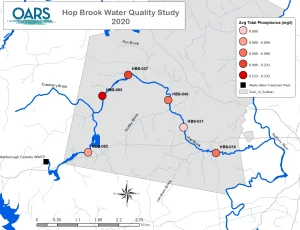Hop Brook Water Quality Study
December 12, 2020
Published December 12, 2020

Why does Hop Brook have some of the highest levels of nutrient pollution in the watershed?
Hop Brook in Sudbury is a major tributary of the Wild & Scenic Sudbury River. OARS’ monitoring of the Sudbury River found that levels of the nutrient phosphorus where Hop Brook enters are unusually high. The Hop Brook Protection Association has also been struggling to control nuisance algae and aquatic plants in the impoundments behind the three mill dams along Hop Brook, particularly Carding Mill Pond.
In 2020, OARS started water quality monitoring at six sites on Hop Brook to map phosphorus concentrations and identify the sources. Two teams of trained volunteers collected water samples at five new sites upstream of our original site (HBS-016), chosen strategically to rule in or out each brook tributary. Monthly sampling was in August, September, and October.
Data analysis showed the same pattern in all three months: highest phosphorus levels at the first site downstream of Carding Mill Pond, almost four times as high as the levels at our original site (HBS-016), and steadily dropping downstream. The Marlborough Easterly wastewater treatment plant at the headwaters of Hop Brook is meeting its strict permit limits. It has significantly reduced its phosphorus discharges over the last two decades and cannot be the source of these high phosphorus levels.

The data also showed an unexplained increase in phosphorus between the Union Avenue and Landham Road sites (HBS-031 and HBS-016), implying that phosphorus could be coming from Landham Brook. In addition, ammonia was high, and dissolved oxygen was relatively low just downstream of Carding Mill Pond. If ammonia and dissolved oxygen levels weren’t so inhospitable, this would be a perfect habitat for fish.
In 2021, OARS plans to fine-tune the sampling sites to pinpoint the sources of phosphorus.
This work was made possible through funding from the River Network.

